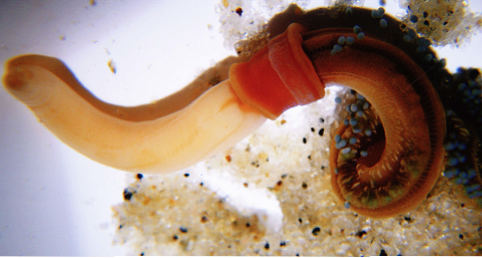Seabed worm is ‘long lost relative’ of human beings
Scientists have been able to gain insight into the 570 million-year evolution of gills into the pharynx after doing genome sequencing of two species of acorn worms. “Acorn worms look very different from chordates, which makes it especially surprising that they and chordates, like humans, are so similar on the genomic, developmental and cell biological levels”.
Acorn worms were the ancestral genomes of chordates, the animals with backbone and hollow nerve cords like humans and other vertebrates. Pharynx constitutes the thyroid gland, tongue, larynx (voice box) and various glands and muscles between the mouth and the throat.
Acorn worms or enteropneust hemichordates, together with echinoderms and chordates are the three phyla that compose deuterostomes.
“Our analysis of the acorn worm genomes provides a glimpse into our Cambrian ancestors’ complexity”, said Dr. Simakov, lead author of the worm study, “and supplies support for the ancient link between the pharyngeal development and the filter feeding life style that ultimately contributed to our evolution”. Researchers from Okinawa Institute of Science and Technology Graduate University (OIST) and its collaborators have studied acorn worms, sequencing the genomes of two separate species.
Say hello to your long-lost relative – this fleshy pink worm living on the seabed is a distant cousin of humans and shares about 70% of our genes.
Of all deuterostomes alive now, acorn worms have been around the longest.
Species like the acorn worms can help scientists understand how genes that first appeared hundreds of millions of years ago control the development of different but related physical features across animal species.
The divergence in our genes happened over 550 million years ago when our genetic line forming the upper and lower pharynx system that we and animals use today split from the gill system that the worms possessed.
Acorn worms are actually marine creatures that live on the ocean floor and feed by filtering a steady flow of sea water through slits in the region of their gut between the mouth and esophagus. But even in later species, a few physical features can still be linked to genes in acorn worms for simpler structures that perform the same jobs, Simakov and his colleagues found.
The video above shows a Saccoglossus kowalevskii (acorn worm) adult digging and feeding.
A particularly interesting cluster is a group of six ordered genes that are all implicated in the development of the pharynx and gill slits in both acorn worms and vertebrates.
These are known today as “acorn worms”, so named because the shape of their heads resembles that of an acorn.








